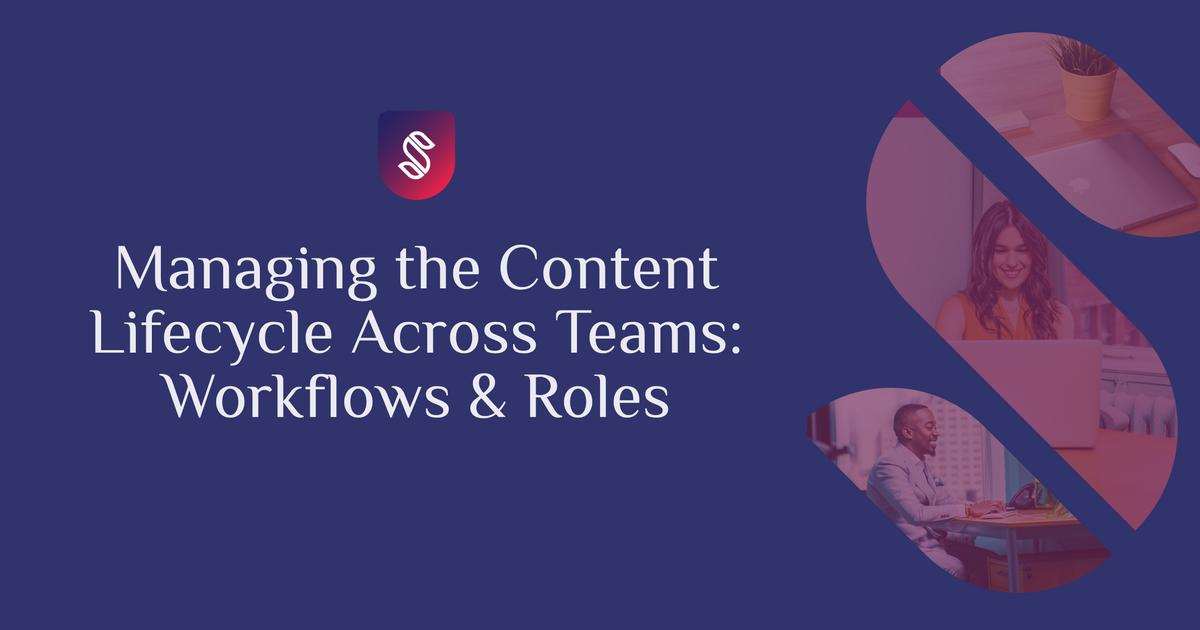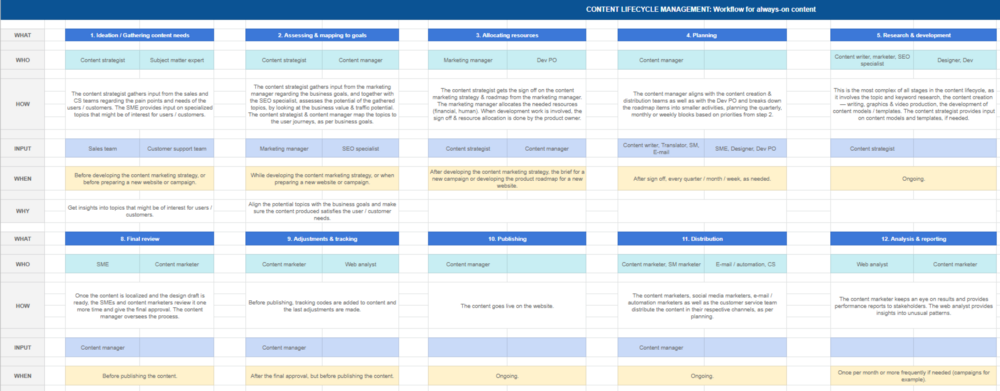Written on 12th May, 2022 | 5 min read
Managing the Content Lifecycle Across Teams: Workflows & Roles
Align your content teams by implementing clear processes
Andreea Macoveiciuc
Strategist @School of Content

In large enterprises where multiple teams are creating content, bringing up the topic of centralizing the content production and management can create friction, especially if the local teams know the markets better.
To avoid internal misalignments and improve the efficiency of your content processes, you can distribute the ownership of the different content lifecycle stages across teams and roles.
Content lifecycle stages
The term content lifecycle describes the process through which each piece of content goes throughout its existence, from the initial stage of idea generation to the last phase of archiving.
Broadly speaking, the content lifecycle can include the following stages:
Ideation — coming up with ideas for content production, based on user needs and pain points
Keyword/topic research — diving into the generated ideas and assessing their relevance and potential (traffic/business value )
Planning — splitting the work into tasks, assigning responsibilities to team members and scheduling the creation, publication, and distribution deadlines.
Creation/curation — the actual production of content, or the editing of existing content with the purpose of reusing it in a different form
Review & approval
Localization — translation and adaptation of content to local markets
Templating — this applies if you take a content-driven design & development approach
Final review
Adjustments & tracking
Publication
Distribution — this phase should include both online and offline channels if used
Performance analysis & reporting — this phase includes the stakeholder updates
Optimization & maintenance
Archiving
In order to manage these phases effectively, the teams involved in the content lifecycle need to have a clear understanding of the workflows, dependencies, and responsibilities of each team member in the process. At the same time, there should be as little grey or overlapping areas as possible.
In the next section, we will look at a general content management workflow for always-on content, but you can apply the same setup to social media content or event-driven content campaigns.
NOTE: Please be aware that these processes may look very different depending on the size, composition, and distribution of your marketing team.
Workflow for managing content across teams
The content lifecycle describes the stages that content undergoes throughout its life, but simply making your team aware of these phases doesn’t guarantee that they’ll effectively manage the content.
“Figuring it out” is not the way to go if you’re serious about improving the efficiency of your content operations and turning content into a business asset. To avoid chaos and conflicts, you should start looking at the content lifecycle management as the administration of your company’s content.
Just like you have an office manager or administrator who oversees the daily operations and makes sure everything goes well with your employees, you need a content manager who oversees the full content lifecycle.
At the same time, you need a content writer whose sole responsibility is to create content and a content marketer who focuses on promoting that content and reaching the right audience.
You also need a content strategist who is responsible for developing the full content strategy but is less involved in the daily operations.
Given below is a generic workflow for a team with the following composition:
Content strategist — central team
Content manager — central team
Content writers / Subject matter experts (SME) — local teams/business units
Designer — central team
Translators — local teams
Content marketers — local teams
Social media marketers— local teams
E-mail/automation marketers — local teams- Customer support — local teams
Data analyst — central team
Web analyst — central team
SEO specialist — central/local teams
I haven’t included paid channels here, but you can adjust the workflow based on your team’s structure. The first tab is filled in, but the second one is left empty, so you can customize it as per your needs.
Content management workflow template

Image: content management workflow template
I will detail the process here, but you can skip this part if you prefer to read the explanation directly in the template.
Ideation & gathering content needs
The content strategist gathers input from the sales and CS teams regarding the pain points and needs of the users/customers. The SME provides input on specialized topics that might be of interest to users/customers.
Assessing & mapping the content topics to business goals
The content strategist gathers input from the marketing manager regarding the business goals, and together with the SEO specialist, assesses the potential of the gathered topics, by looking at the business value & traffic potential.
The content strategist & content manager map the topics to the user journeys, as per business goals.
Allocating resources
The content strategist gets the sign off on the content marketing strategy & roadmap from the marketing manager.
The marketing manager allocates the needed resources (financial, human). When development work is involved, the sign-off & resource allocation is done by the product owner.
Planning
The content manager aligns with the content creation & distribution teams as well as with the Dev PO and breaks down the roadmap items into smaller activities, planning the quarterly, monthly, or weekly blocks based on priorities from step 2.
Research & Development
This is the most complex of all stages in the content lifecycle, as it involves the topic and keyword research, content creation — writing, graphics & video production, the development of content models/templates.
The content strategist provides input on content models and templates if needed.
Review & approval
The SMEs review the technical accuracy of the content. The content marketers review the grammar, style, tone of voice, and structure of the content, to make sure it satisfies the requirements. Once the content is approved, the content manager sends it to localization.
Localization & templating
The translators localize the content, and the UX and DEV team develop the templates, with input from the content strategist. The content manager oversees the processes.
Final review
Once the content is localized and the design draft is ready, the SMEs and content marketers review it one more time and give the final approval. The content manager oversees the process.
Adjustments & tracking
Before publishing, tracking codes are added to the content and the last adjustments are made.
Publishing
The content goes live on the website.
Distribution
The content marketers, social media marketers, e-mail/automation marketers as well as the customer service team distribute the content in their respective channels, as per planning.
Analyzing & reporting
The content marketer keeps an eye on results and provides performance reports to stakeholders. The web analyst provides insights into unusual patterns.
Optimization and maintenance
When content is underperforming, the content strategist and SEO specialist provide input and ideas on optimization opportunities. The content marketer and manager update & maintain the content.
Archiving
When content no longer serves a business objective, it can be archived. The content manager takes care of redirects, with input from the SEO specialist.
I hope this gives you a good overview of the workflow and roles involved in managing the content lifecycle. As you can see, the process can be quite complex, so ideally you should have a CMS that allows you to set up workflows and authoring roles.
If you need help in managing your content lifecycle and defining efficient processes and workflows, get in touch with our team.